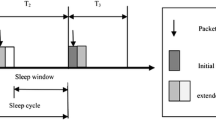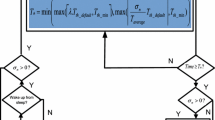Abstract
Frequent use of various mobile application services consumes a great amount of battery power in mobile devices. In order to satisfy user convenience and keep the portability of mobile devices, a power saving mechanism is essential for the success of mobile communication technologies. This paper evaluates performances of the power saving mechanism of IEEE 802.16m, one of the solutions for the fourth generation mobile communication technology. When a mobile device does not communicate with a base station, it temporarily shuts down communication-related modules and circuits in order to save the battery power. During that period, the device cannot listen to incoming traffic from the base station, which causes an inevitable delay at the expense of reducing power consumption. Arriving packets are transmitted only after the device enters either the awake mode or the listening window in the sleep mode. Four power saving mechanisms are examined in the simulation:1) fixed maximum operating parameters, 2) fixed minimum operating parameters, 3) moving average policy, and 4) exponential increase policy. To evaluate the performance of the sleep mode operation in IEEE 802.16m, an analytical model is developed for delay time based on M/D/1 queueing system. Performances of the power saving mechanisms are evaluated with Poisson and traffic models for five applications: WEB, FTP, GAME, VIDEO, and VOICE, which reflects real service environment.




Similar content being viewed by others
Notes
AMS and ABS are the technical terms used in IEEE 802.16m as a mobile station and a base station.
References
3GPP TS36.300. Evolved Universal Terrestrial Radio Access (E-UTRA) and Evolved Universal Terrestrial Radio Access network (E-UTRAN): overall description
IEEE Std. 802.16m-2011 (2011) IEEE standard for local and metropolitan area networks - part 16: air interface for fixed broadband wireless access systems, Amendment 3: advanced air interface
EARTH, EC FP7 project 247733, http://www.ict-earth.eu
Green Touch Initiative. http://www.greentouch.org
Pentikousis K (2010) In search of energy-efficient mobile networking. IEEE Commun Mag 48:95–103
Etoh M, Ohya T, Nakayama Y (2008) Energy consumption issues on mobile network systems. Proceedings of International Symposium on Applications and the Internet 2008, pp. 365–368
Kim R, Mohanty S (2010) Advanced power management techniques in next-generation wireless networks. IEEE Commun Mag 40(3):94–102
Choi J, Kim M, Jeong H, Park H (2012) Power-saving mechanisms for energy efficiency IEEE 802.16e/m. J Netw Comput Appl 35(6):1728–1739
Kim M, Choi J, Kang M (2008) Trade-off guidelines for power management mechanism in the IEEE 802.16e MAC. Comput Commun 31(10):2063–2070
Hwang E, Kim K, Son J, Choi B (2010) The power-saving mechanism with periodic traffic indications in the IEEE 802.16e/m. IEEE Trans Veh Technol 59(1):319–334
Chen C, Hsu C, Feng K (2010) Performance analysis and comparison of sleep mode operation for IEEE 802.16m advanced broadband wireless networks. Proceedings of IEEE International Symposium on Personal Indoor and Mobile Radio Communications (PIMRC 2010), pp. 1425–1430
Park Y, Leem H, Sung D (2010) Power saving mechanism in IEEE 802.16m. Proceedings of Vehicular Technology Conference (VTC 2010)
Jin S, Choi M, Choi S (2010) Performance analysis of IEEE 802.16m sleep mode for heterogeneous traffic. IEEE Commun Lett 14(5):405–407
Nga D, Kim M, Kang M (2007) Delay-guaranteed energy saving algorithm for the delay-sensitive applications in IEEE 802.16e systems. IEEE Trans Consum Electron 53(4):1339–1347
Choi J (2011) Power saving mechanism for advanced mobile station in IEEE 802.16m. J Korea Inf Commun Soc 36(12):959–965
Choi J (2012) An adaptive sleep cycle control algorithm considering packet arrival information in IEEE 802.16m. J Korean Inst Next Gener Comput 8(4):58–65
IEEE Std. 802.16/Cor1/D3-2005 (2005) IEEE standard for local and metropolitan area networks - part 16: air interface for fixed broadband wireless access systems
Bertsekas D, Gallager R (1992) Data networks. Prentice-Hall, Upper Saddle River
IEEE 802.16m (2009) Evaluation Methodology Document (EMD), IEEE 802.16m-08/004r5
Sequans communications. Datasheet: SQN1130 System-on-Chip (SOC) for WiMAX Mobile Stations
Acknowledgments
This research was funded by the MSIP (Ministry of Science, ICT & Future Planning), Korea in the ICT R&D Program 2014.
Author information
Authors and Affiliations
Corresponding author
Rights and permissions
About this article
Cite this article
Lee, K., Choi, J. & Ma, J. Performance evaluation for delay time estimation in IEEE 802.16m sleep mode. Peer-to-Peer Netw. Appl. 8, 886–895 (2015). https://doi.org/10.1007/s12083-014-0262-6
Received:
Accepted:
Published:
Issue Date:
DOI: https://doi.org/10.1007/s12083-014-0262-6




